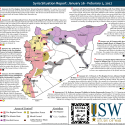 |
 |
Syria Situation Report: January 26 - February 2, 2017
Feb 2, 2017 - Chris Kozak


The new administration of U.S. President Donald Trump floated initial signals of significant policy changes regarding the Syrian Civil War. President Trump held an hour-long telephone conversation with Russian President Vladimir Putin on January 28 that included discussions of “mutual cooperation” against ISIS in Syria. The Kremlin later claimed that the two leaders agreed to “establish real coordination” against “terrorist groups” operating in Syria without providing further details. President Trump later held telephone conversations with Saudi King Salman bin Abdul-Aziz and United Arab Emirates Armed Forces Deputy Supreme Commander Mohammed bin Zayed on January 29 to solicit the support of both countries for an unspecified initiative to establish ‘safe zones’ in Syria. The Syrian Foreign Ministry warned that any attempt to establish a ‘safe zone’ on its territory without coordination with the regime would be an “unsafe act” and violation of national sovereignty. At the same time, the U.S. Department of Defense is preparing a number of options to accelerate the campaign against ISIS in Syria including broader battlefield authorities, an expanded train-and-assist mission for vetted opposition groups, arms deliveries to the Syrian Kurdish YPG, and the deployment of a combat brigade to seize Ar-Raqqa City. Nonetheless, concrete details on the ultimate policy of the new administration towards the conflict remain unclear even as the regime and opposition prepare for new round of Geneva Talks scheduled for February 20.
These graphics mark the latest installment of our Syria SITREP Map made possible through a partnership between the Institute for the Study of War and Syria Direct. The graphic depicts significant recent developments in the Syrian Civil War. The control of terrain represented on the graphic is accurate as of January 26, 2017.